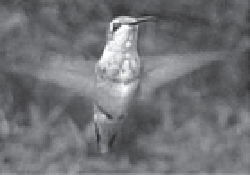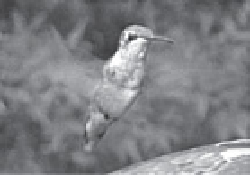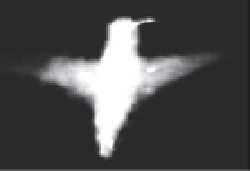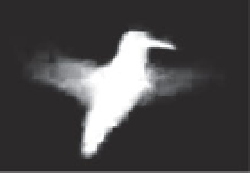Graphics Reference
In-Depth Information
A fixed-width ribbon of pixels around the segmentation boundary is then com-
puted; inside this region
is allowed to be fractional. For each line through the
ribbon perpendicular to the boundary, a sigmoid-like profile that smoothly ranges
from 0 to 1 is estimated, so that the profiles at adjacent lines are similar. We note that
this approach of using a fixed-width ribbon is likely to fail for objects with large wispy
regions, such as the image in the second row of Figure
2.4
.
α
2.9
VIDEO MATTING
So far, this chapter has focused on the problem of natural image matting from a
single image. Of course, for visual effects, we must compute mattes that last several
seconds, resulting in hundreds of frames (Figure
2.22
). The result is sometimes called
a
traveling matte
. Certainly, any of the methods outlined earlier may be applied
frame by frame, but the process would be extremely time-consuming, and it would
impractical to expect a user to provide a trimap or scribbles in each frame. Further-
more, there is no guarantee that the results from adjacent frames will vary smoothly,
which could lead to visually unacceptable “jitter.” In this section, we overview tech-
niques for
video matting
, which exploit the temporal coherence of the input video
and desired output mattes.
Just as single-image matting is related to image segmentation, video matting is
related to the well-known problemof
visual tracking
. The goal of visual tracking is to
estimate the location of one or more objects in a video sequence, preferably ensuring
that the estimated locations vary smoothly and that tracking is not lost in the presence
of occlusions or object crossings. However, despite the huge amount of research and
substantial advances in the field of tracking, most suchmethods are not immediately
applicable to video matting for the same reason that many segmentation results are
not immediately applicable to single-image matting. That is, the output of a typical
tracking algorithm is a bounding rectangle or ellipse for each object, which is much
too coarse to use for high-quality matting and composition. Even if the estimated
foreground pixels in each frame form a relatively tight fit around the object, we still
Figure 2.22.
Video matting requires many similar matting problems to be solved over a large
number of frames.








